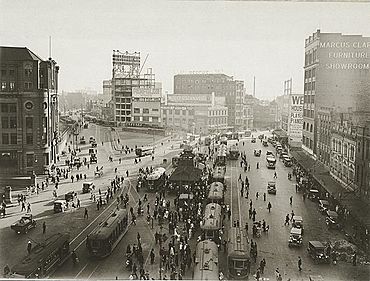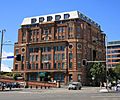Railway Square, Sydney facts for kids
Quick facts for kids Railway SquareSydney, New South Wales |
|||||||||||||||
|---|---|---|---|---|---|---|---|---|---|---|---|---|---|---|---|

Railway Square tram interchange early 1900s
|
|||||||||||||||
| LGA(s) | City of Sydney | ||||||||||||||
|
|||||||||||||||
Railway Square is a busy public space in Sydney, New South Wales, Australia. It's located at the southern edge of the city's main business area. This square is where several important streets meet, including Broadway, Lee Street, Pitt Street, and George Street.
Railway Square is a very active intersection and a major hub for buses. Nearby, you'll find the University of Technology, Central railway station, and the former Kent Brewery.
Contents
A Look Back: Railway Square's History
Railway Square was once called Central Square. In the 1800s and early 1900s, it was a very important shopping area. This was because the Central railway station was right next door. Many hotels were also built nearby to welcome visitors arriving by train.
Big department stores like Marcus Clark had shops around Central Square. The Parcel Post Office, a building for sending mail, was built in 1913. It was designed by a government architect named George McRae. Later, this building was updated and became the Medina Hotel.
Trams and Buses at the Square
This area was also a busy spot for Sydney's electric tramways. Trams were like electric streetcars that ran all over the city. The tram system closed down in the late 1950s.
Until the 1990s, Railway Square had a special bus terminal in its middle. It had three platforms for buses. These platforms were connected by an underground walkway, which was an extension of the Devonshire Street Tunnel. You could reach the tunnel using escalators.
In 1999, Railway Square was updated. It now has two bus platforms, lifts, and a cafe. It also provides easy access to the University of Technology. The area features cool public art by Merilyn Fairskye. This art includes murals, lit-up wall panels, and four towers with colorful steel ribbons. These ribbons represent the four elements: Air, Water, Earth, and Fire. Today, Railway Square is known for its tall glass bus terminal and the four artistic light towers. It's still a major hub for State Transit Authority bus routes.
The Old Railway Tunnel Underneath
Railway Square has more than just the pedestrian tunnel running below it. There's also an old railway tunnel at the southern end. This tunnel is called the Darling Dive.
Sydney's Oldest Railway Tunnel
The Darling Dive tunnel was part of the Metropolitan Goods line. This line used to connect the main railway lines from Central Station to Darling Harbour. This tunnel is actually the oldest railway tunnel in New South Wales! It is no longer used for trains.
The part of the old railway line between the tunnel and the Powerhouse Museum has been turned into a park. It's now a walking path called The Goods Line. The section of the line beyond the Powerhouse Museum has been changed into a light rail track.
Gallery
Images for kids













